Blog
Archives
.
. . from 2012 to current
SUNDAY
JUNE 14 - 2015
Brook
Meadow
I was pleased
to meet up with Tom Bickerton for the first time this
morning, having corresponded with him many times over
the years. Tom was birdwatching on Brook Meadow with a
colleague, but they had not seen much when I met
them.
Later, I had my first Meadow Brown of the year
on Brook Meadow on the Lumley area. The date is about
the same as in previous years.
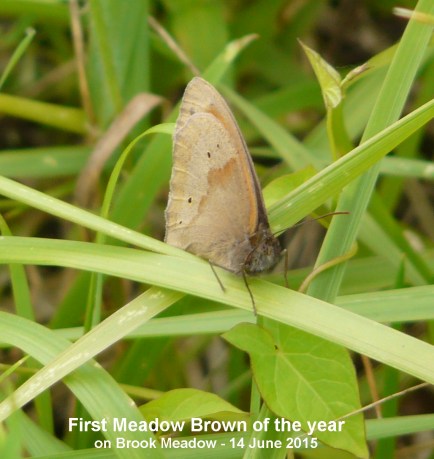
Broad-leaved
Willowherb (with crossed stigmas in its flowers)
is flowering on the south bridge.
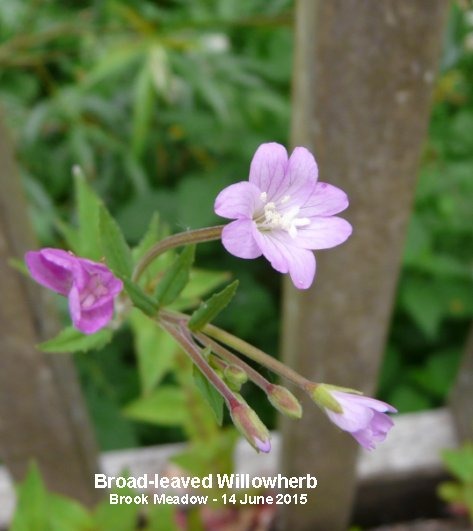
Rare
sedges
Martin Rand
commented on my description of Slender
Spike-rush (Eleocharis uniglumis) on Brook
Meadow as 'a very rare sedge':
He says, If you're talking in a national context I
think it's not quite accurate to describe
Eleocharis uniglumis as a "very rare sedge". It
is widespread albeit rather localised in Britain. Your
Carex divisa (Divided Sedge) is a much
better candidate: it's largely restricted to the
coasts of SE England and the shores of the Humber,
with just a few outliers elsewhere, and is listed as
"Vulnerable" on the UK Red List.
Slipper
Millpond - chicks dead
When I arrived
to check the Great Black-backed Gull nest on
Slipper Millpond this morning, I could not see any
sign of the chicks on the raft, but assumed they were
hiding in the thick vegetation. However, both the
adult gulls were perched on top of the lamp posts on
either side of the main road near the Hermitage
Bridge. I could not understand what was going on and
why the adults were not on the raft with the chicks.
While I was standing on the bridge, one of the birds
swooped down low over my head seemingly distressed.
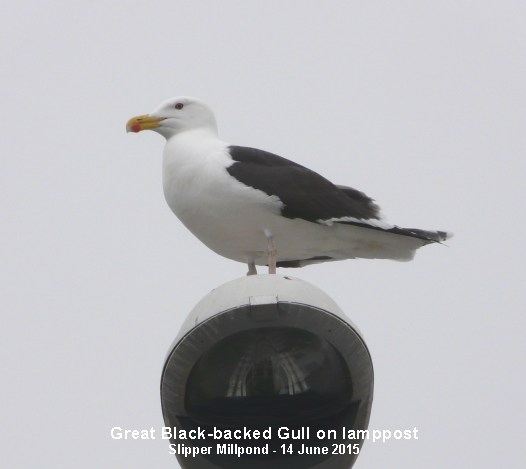
The mystery was solved
by a phone call that I had later in the day from
Sharon who lives in Slipper Road (No 7) opposite the
nesting raft. She said both the gull chicks were dead.
She had seen them in the water having fallen off the
raft. Their downy feathers were waterlogged and they
were unable to get back on the raft on despite
attempts by the adults to help them. So, that is that
for another year. The first time they have failed to
produce young in four years of nesting on the
raft.
What I assume was a new pair of Mute Swans was on the
pond, the cob seemingly having found itself a new
mate.
Lesser Sea-spurrey is now flowering well near the
kissing gate on the west side of the pond.
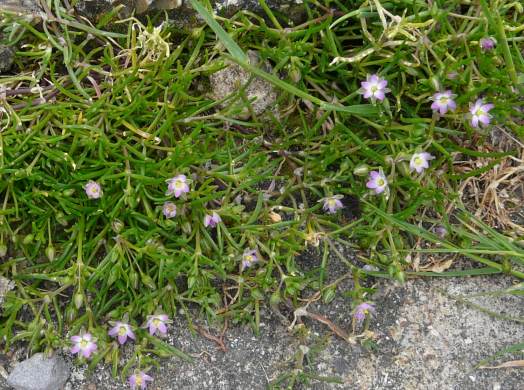
Hayling
Oysterbeds
Chris Cockburn
provides the latest news from the oysterbeds.
"Common tern chicks are now in evidence on the
straight island in the Oysterbeds' lagoon; but they
are often being brooded by adults during the
predominantly breezy and cool conditions that are
prevailing so much this year. Presently, there does
not seem to be a problem with the quality of fish prey
being brought into the colony; but when winds reach
Beaufort Force 5 or higher, the terns do have problems
in capturing the fish. Like the black-headed gulls,
the common terns are at various stages of breeding;
there are some with chicks, some that should be
hatching soon and others that are only just starting
to nest-scrape.
The biggest
concentration of black-headed chicks is still on the
western end of the straight island and they range from
the very small to ones growing feathers. The second
wave of hatching, following the tidal flooding on 05
May, is well under way on the curved island and on the
eastern end of the straight island. However, there are
yet many gulls brooding eggs.
The pair of
oystercatchers that started nesting three weeks
ago on the western end of the straight island are now
nesting on the north spit of Stoke Bay, a site
favoured by oystercatchers in previous years. This
site is, unfortunately, prone to disturbance by people
and by dogs. The eggs of the pair of oystercatchers
nesting on the eastern end of the straight island are
probably within a week of hatching.
Apart from Holly
Blues, Green-veined Whites and Speckled Woods, the
numbers of most butterfly species and other insects
has been disappointingly low so far, both on the West
Hayling LNR and on the Billy Trail. However, on 12
June, there were at least five Painted Ladies near the
Oysterbeds on Friday last and a Small Tortoiseshell
was seen yesterday.
Many plants have had a
good and prolonged flowering season and Milk Thistles
on the Oysterbeds' Mound are in abundance after recent
lean years. Bee orchids are coming into bloom on the
Billy Trail and at the Oysterbeds where a cluster of
at least eight plants has appeared on the south bank
of the mound.
FRIDAY
JUNE 12 - 2015
Brook
Meadow
I had a mooch
around the meadow this morning and discovered a few
more orchids. One more Common Spotted Orchid
was out on the orchid area taking the total so far to
9. I also found 3 more Bee Orchids, 2 on the
orchid area and one on the Lumley area taking their
total to 8.
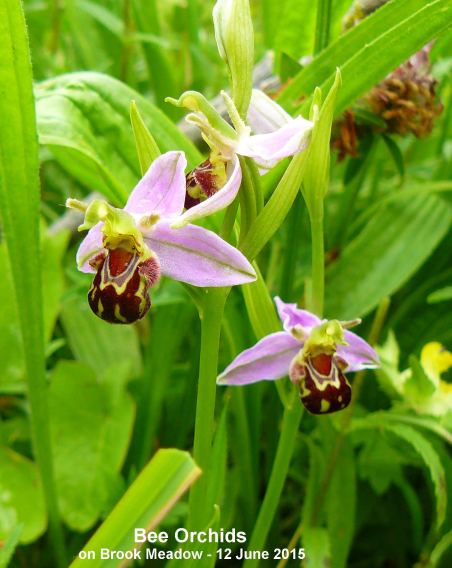
The flower heads of
the Great Burnet plants are growing and turning
bright red. Photos to come later when in full
flower.
The first Hedge Bindweed flowers are out on the
Lumley area. In Hedge Bindweed the sepals are enclosed
by two pouch-like bracteoles, but these do not overlap
and so the sepals remain visible - see marker in
photo. In Large Bindweed the bracteoles are strongly
overlapping hiding the sepals.
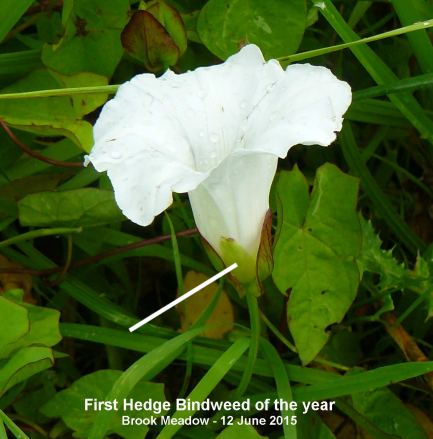
A
grass to admire
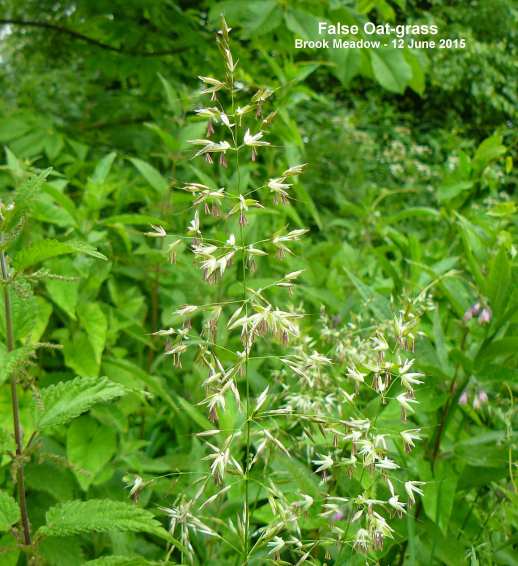
Emsworth
Recreation Ground
The grassland
immediately behind the bowling club on the Recreation
Ground usually has an interesting selection of plants
and today was no exception. The grasses included Sweet
Vernal Grass, Yorkshire Fog and a small amount of
Crested Dog's-tail.
I always look forward to seeing the Bent-grasses
which grow well on this grassland. I have always
assumed they were Creeping Bent-grass from the long
pointed ligules. However, today, I took a few samples
to examine the spikelets with the microscope and found
they had long bent awns coming from the lemmas. This
would be very unusual in Creeping Bent-grass, so my
guess is that the grass is in fact Velvet Bent-grass.
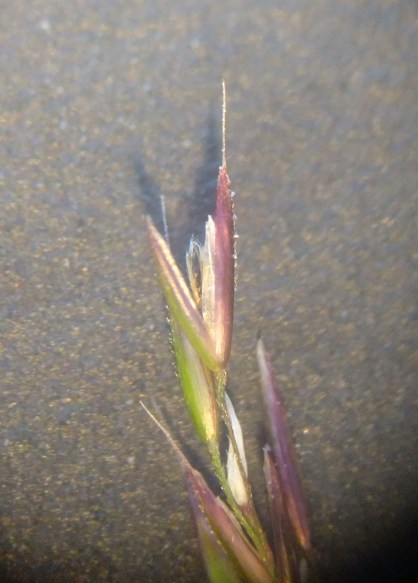
I was also very
pleased to see the usual small area of Meadow
Barley near the gate to the pony field - my first
of the year. Other plants in this area included an
excellent show of Lesser Stitchwort, plus some Common
Sorrel, Bird's-foot Trefoil and Field Wood-rush. What
I assume are the Hairy Buttercups are in flower
along the track leading to the gate in the far north
west corner of the ground leading to Horndean Road,
though I did not dig them up to confirm.
Wild
Clary - comes and goes
Once again the
council cutting team have mown the Wild Clary growing
on the grass verge in Christopher Way. I presume they
will come up again, as they have each time in the
past. A tough plant. However, the three plants on the
main uncut wayside are still there and growing.
Stag
Beetle
My neighbours,
Rob and Tina went for a walk along the shore last
evening to Nore Barn and discovered this cracking male
Stag Beetle on the shingle. They are named after their
large jaws (antlers) which the males use to fight
rivals in the breeding season.
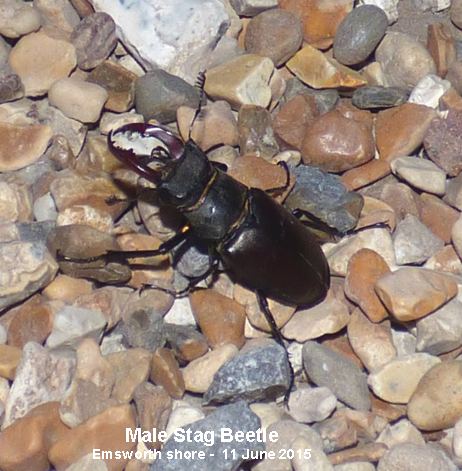
The female Stag Beetle
is smaller and lacks the antlers as shown in this
photo from Thomas Irons.
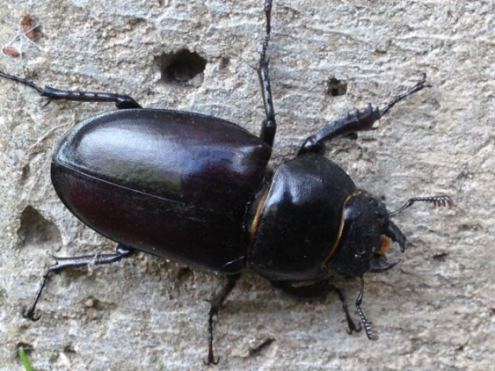
Fort
Purbrook
Jill Stanley
eventually got to Fort Purbrook - this morning and
found the Common Spotted orchids in full flower with
the Pyramidal ones just opening up - they tend to be a
bit later - but there are hundreds of both. Jill also
noted Bladder Campion, Greater Knapweed and Knapweed
Broomrape which is parasitic on the Knapweed. A great
place to visit at this time of the year.
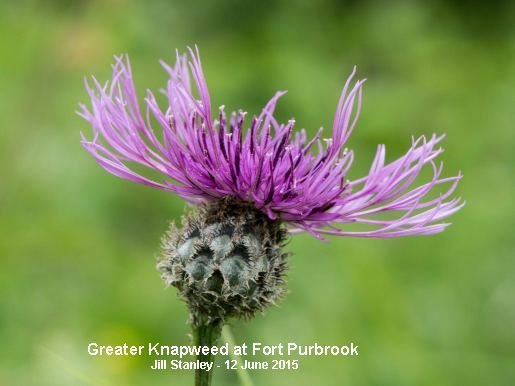
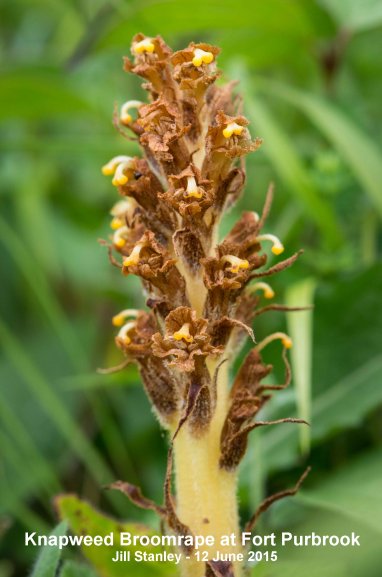
Hampshire
Farm
Chris Oakley
sent me this astonishing photo of part of the
Hampshire Farm open space literally covered with Oxeye
Daisies. Oxeye Daisy is, in fact, a native plant,
though I assume this vast swathe was sown here by the
developers.
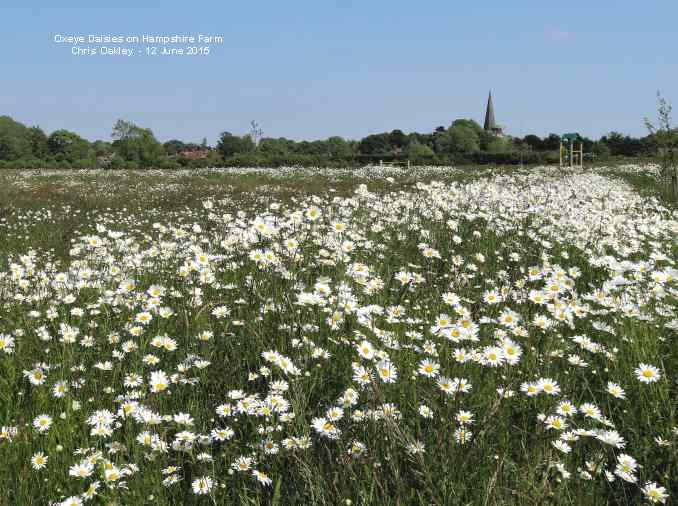
THURSDAY
JUNE 11 - 2015
South
Moor
It was a
glorious sunny and warm morning, so I decided to go
down to South Moor to see how the Southern Marsh
Orchids were getting along. This is by far the best
site locally to see these magnificent orchids.
Parking at the end of Southmoor Lane I walked along
the path going east onto the South Moor. I had to
clamber over the specially constructed wooden fence to
get onto orchid area itself as the nearby gate was
bolted. However, there is no problem about access.
The moor was unusually dry with short grass - probably
indicating that grazing had taken place over the
winter? This made walking much easier than it usually
is and I had a very enjoyable morning. The moor itself
was looking exceptionally beautiful with swathes of
red Common Sorrel and yellow buttercups dotted
around all over These were supplemented by large
patches of Yellow Flag and pink Ragged Robin and the
tiny white flowers of Lesser Stitchwort were
everywhere.
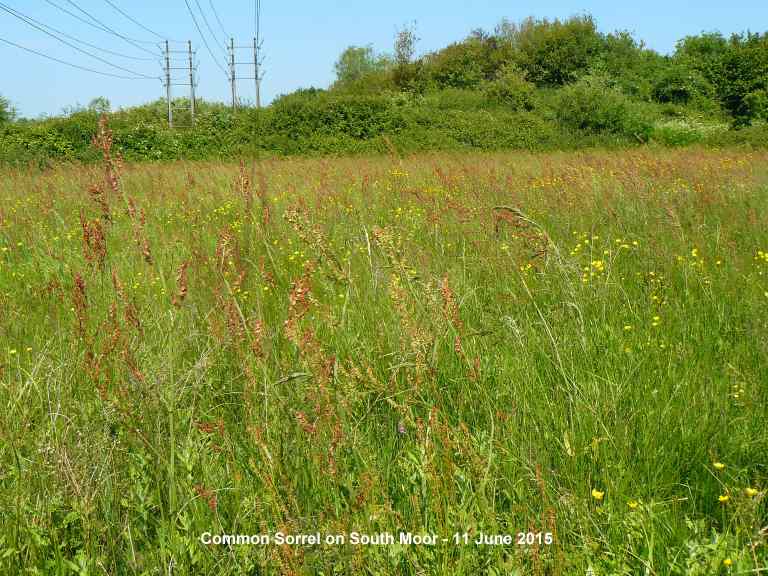
Southern
Marsh Orchids
The Southern
Marsh Orchids were looking in good shape with probably
more to come before the official count on June 20th.
As the grass was short they were easy to see, though
they seemed to be more spread out over the moor than
usual.
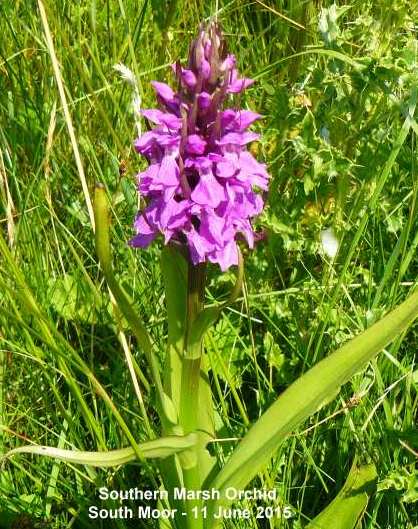
Orchid counts have
been taking place on the South Moor since 1995 at Grid
Ref: SU 712 052. In 1995 and 1996 Ralph Hollins
counted them and since then they have been counted by
the local Hampshire Wildlife Trust Havant Wildlife
Group under the supervision of Nigel Johnson. Last
year there was a record count of 10,690 flowering
spikes! This beat the previous best of 9234 in 2010 by
over a thousand. It will be interesting to see what
this year's count will be.
Greater
Spearwort
I was pleased
to find a good flowering of Greater Spearwort in a
marshy area of the moor well away from the other
buttercups. This was a new plant for me on the moor.
Greater Spearwort is the largest flowered buttercup
with distinctively long narrow leaves. It is hairless
with grooved stems, though the flower stalks are not
grooved - see the photo. It is a native plant, but has
been so widely planted as an ornamental that its range
and abundance as a wild plant are difficult to
determine.
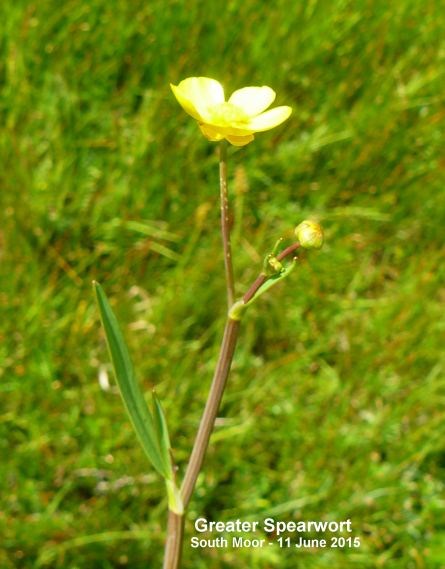
Large
Bittercress
I also found
(what I think/hope) were patches of Large Bittercress
in flower. This is a larger more sprawling plant than
the more common Hairy and Wavy Bittercresses that we
tend to see around town. Its and leaves are divided
into 2-5 pairs of oval leaflets with a larger terminal
leaflet. There is no basal rosette. Its flowers are
larger than the other bittercresses with violet
anthers, though the anthers had all disappeared on the
plants I found.
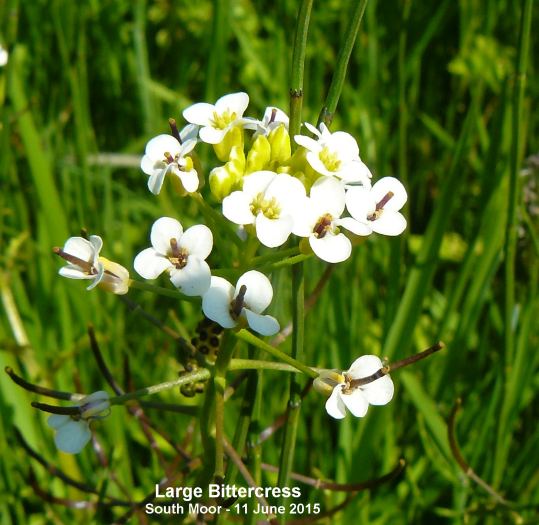
Forget-me-not
I puzzled for
some time over some Forget-me-not flowers hoping they
might be Tufted Forget-me-nots which I know have been
seen on the South Moor in previous years. However, I
was not sure. As, can be seen in the photo, the hairs
on the stem are not flattened as they should be for
Tufted. I also examined the hairs lower down the stem
and they were much the same. Maybe it is Tufted, but
my tentative conclusion is that it is probably Water
Forget-me-not.
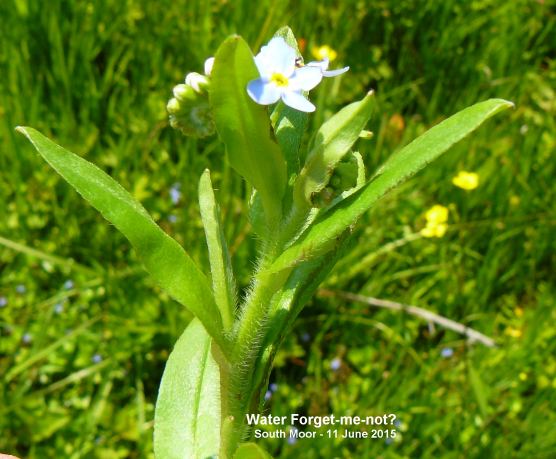
Other
plants
Other plants
noted included Brooklime, Sea Arrowgrass, Hemlock
Water-dropwort and Common Knapweed (not in
flower).
I was pleased to find my first Marsh Thistle
flowers of the year. What a striking plant this is.
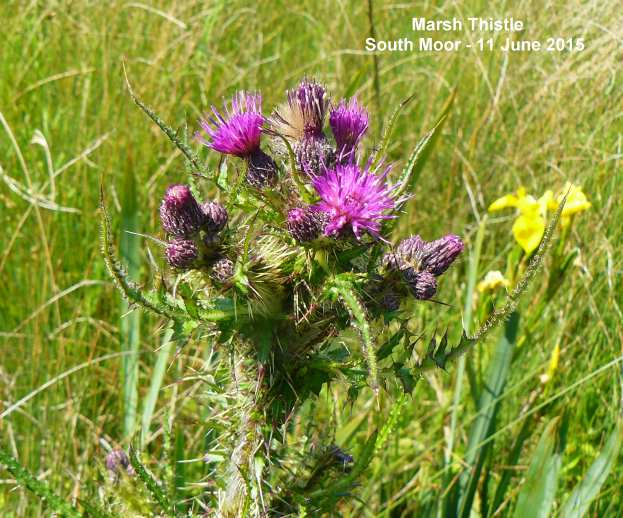
Grasses,
sedges, etc
South Moor is
also very good for grasses, sedges, rushes and
horsetails. Of the grasses, Tall Fescue, Red Fescue
and Marsh Foxtail were widespread, with occasional
Crested Dog's-tail and Sweet Vernal Grass. I was also
pleased to find my first Bent-grass of the year,
probably Common Bent-grass, but still closed up. But
no sign of Plicate Sweet-grass, maybe too dry.
Of the sedges False Fox Sedge was everywhere along
with lots of Divided Sedge. I also found Distant
Sedge, Black Sedge, Brown Sedge and Common
Spike-rush.
Hard Rush, Soft Rush and Compact Rush were showing
flowers, but not Sharp-flowered Rush as yet.
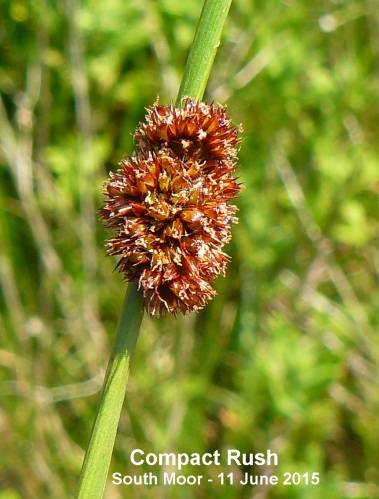
Marsh Horsetail
was widespread with its black cones standing out
well.
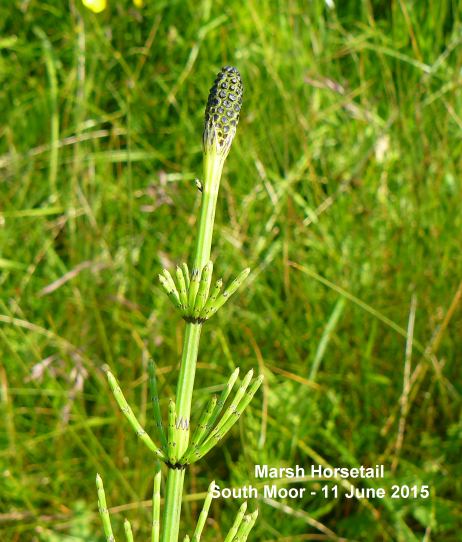
Other
wildlife
The only birds
I heard were a Cetti's Warbler singing
constantly from the bushes to the north of the area
and an occasional Chiffchaff.
Despite the warm morning I saw very few butterflies on
the wing. However, I did see my first Meadow Brown
of the year fluttering past, plus a couple of
Common Blues. Interestingly, Ralph Hollins reported in
his diary last night that Barry Collins found the
first Meadow Browns of the year on Thorney Island on
Monday 8 June.
There was no sign of the Narrow-bordered Five-spot
Burnet moths that I have seen here in the past, but
maybe it is a bit early for them.
Hampshire
Farm
Chris Oakley
and his wife had a walk over Hampshire Farm on a
perfect summer evening. He says, "It was a delight to
be out in the quiet of the meadow. The Ox-eye daisies
were in swathes all across the site, I've never seen
so many in one place. Last year there were some but
never like this. There were several Common Blue
butterflies as well as some Meadow Browns, one Large
Skipper and one extremely pale Small Tortoiseshell.
Swallows were hawking the grass and pond but we saw
only one House Martin".
Chris found some clumps of Grass Vetchling,
which is interesting as I recall finding some on the
site now occupied by the housing estate during a
survey prior to the development. Good to hear they
have survived - and moved across!
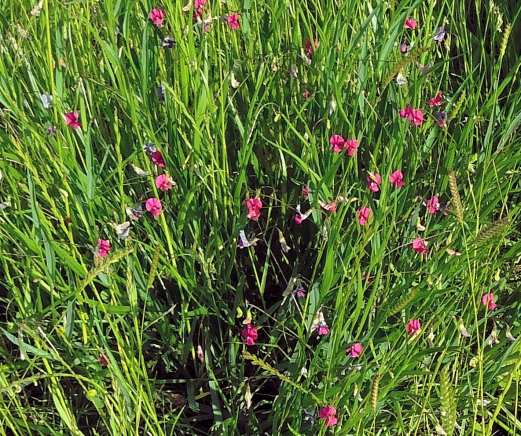
Chris also found a
puzzling Vetch that he could not identify. He
says the flowers were huge by vetch standards being
nearly 2cms long. From Chris's photo the plant looks
looks like Common Vetch, though the size of the plant
is puzzling. Does anyone else have any idea?
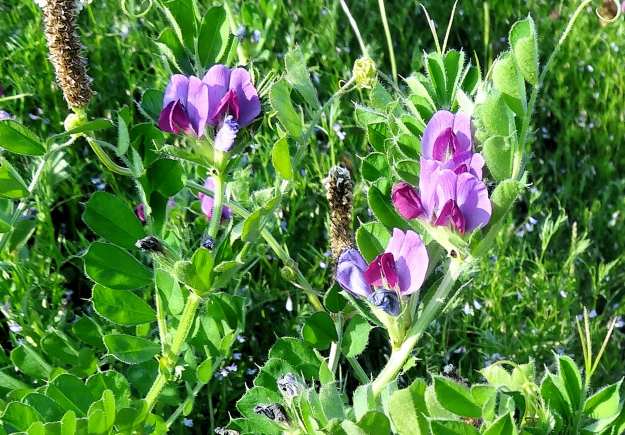
Stansted
Ravens
Chris Oakley
was at Stansted Arboretum today noted that the Ravens
have at least two young which were making quite a
fuss.
WEDNESDAY
JUNE 10 - 2015
Bridge
Road Wayside
I spent this
morning surveying two of our local waysides. Starting
at the Bridge Road Wayside, I donned my wellies and
got into the Westbrook Stream mainly to look for the
very rare Narrow-leaved Water-plantain which
has been growing here since 2006 when it was first
discovered by Nigel Johnson. Martin Rand (BSBI
Recorder for S Hants) has confirmed the identification
indicating that it is a first for this part of
Hampshire.
Sadly, the plants which have numbered up to 30, have
declined dramatically in recent years, probably due to
the flooding of the stream and the clearance work by
the Environment Agency. Now there are no plants to be
seen at all in the stream adjacent to the car park and
I could only find 6 plants in today's survey, all
behind the Bridge Road houses (including mine) towards
the Victoria Road culvert. (SU 74734 06172). Here is
one of them showing the typical narrow leaves tapering
to the base.
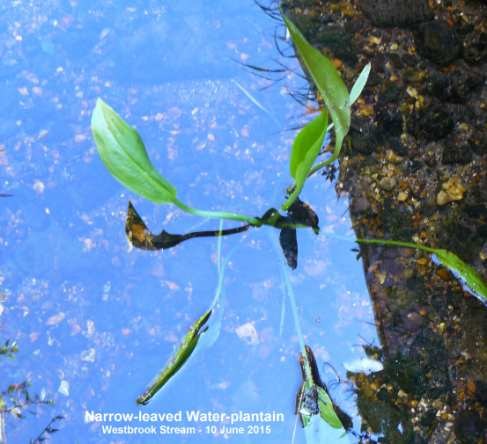
I was pleased to find
some Plicate Sweet-grass had survived on the
denuded banks of the stream, but not as much as in
previous years. The more common grass False
Brome is also showing well on the edges of the
stream, enough, in fact, for me to cut some for my
vase display. However, there was no sign of Blue
Water-speedwell which I have seen in the stream in
previous years. I did find several tufts of Remote
Sedge and some Grey Sedge.
The main downside of the stream survey was that I
dropped my precious Lumix FZ8 camera into the water.
It was saturated. When I got home I opened up the
battery case and left it in the sun to dry out. I hope
it is not permanently damaged.
The grass verge
wayside itself is heavily overgrown with tall grasses,
mostly False Oat-grass, giving little opportunity to
smaller species to grow. Several tufts of False Fox
Sedge are pushing through. There is no sign of any
orchids; last year we had three Bee Orchids near the
Goat Willow tree and a Pyramidal Orchid near the
conservation notice. Wall Lettuce is struggling to
come up beneath the Beech hedge along Bridge Road;
this area was chemically sprayed by the Council which
put paid to most of the small plants. So, overall the
wayside has had a rough year or so.
So far this year I have logged 108 species of plant on
the Bridge Road Wayside and stream out of a total list
of 194. So, there is some way to go. Last year I got
128.
Railway
Wayside
I also did a
survey of the wayside to the north of Emsworth Railway
Station which has become very overgrown since it was
first adopted as a wayside in 2012 with less variety
of plants on show.
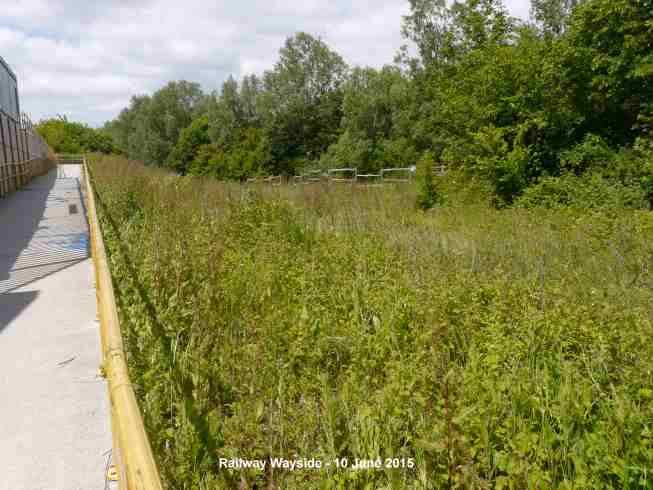
Hedge Woundwort
is in flower, but there is no sign as yet of the
prized Marsh Woundwort, though this is often a bit
later. However, the area at the eastern end of the
wayside where Marsh Woundwort has been most prolific
is now covered with a carpet of brambles and I fear we
might not see much.
Common Knapweed is struggling through the
brambles though not yet in flower as is Perforate St
John's-wort. I was surprised to see the first yellow
petals showing on Common Fleabane. Also, the
first pink flowers are showing on Hemp
Agrimony. Hedge Bedstraw was a new plant
for the wayside list, though not in flower. A blue
Cornflower was out on the embankment near the ramp,
probably from seeds tossed there by passers by, but
rather pretty. Tufted Vetch was out mainly on
the west area of the wayside.
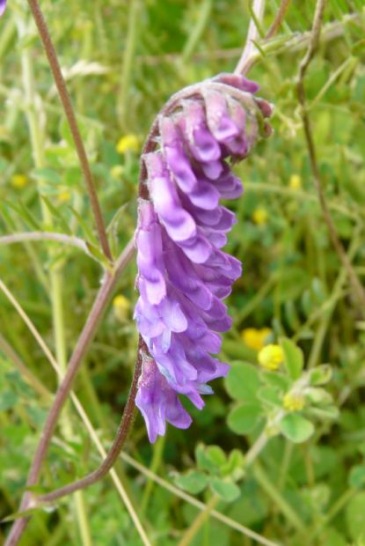
Hoary
Willowherb is a regular flower on this wayside and
it was good to see several of them in flower. This is
a smaller slender version of the more common Great
Willowherb, separated by its smaller paler flowers,
its non-clasping strap-shaped leaves and its softly
hairy stem, appearing greyish, ie 'hoary'.
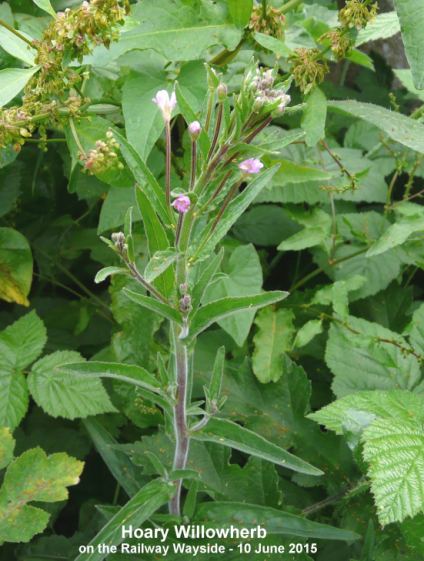
The docks are a tricky
group to separate, but I think the main one on this
wayside at present is Wood Dock - though I
might be wrong!. This is generally found in shady
places, though here it is in the open. Stem is
straight with many branches arising at a narrow angle
to the stem (< 30 deg). It has flowers arranged
along the spike in well-spaced reddish whorls with
clusters of small untoothed tepals of which only one
has a large rounded red wart.
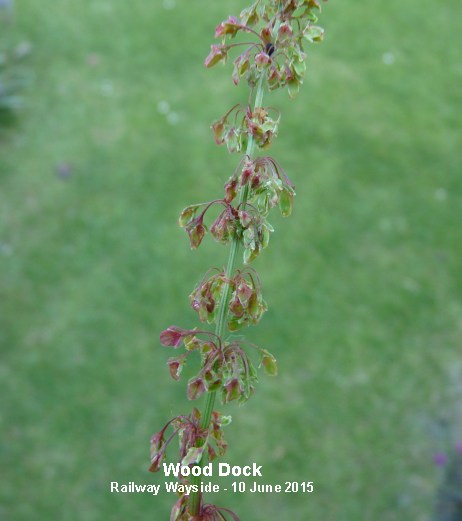
Just over the border
onto the highways area I found my first Crested
Dog's-tail grass of the year, showing its typical
one-sided stalked flower spike.
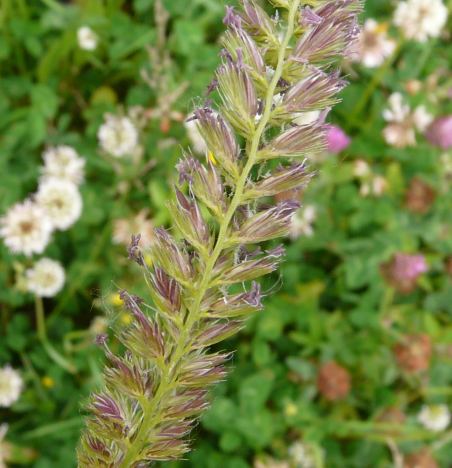
The small wayside
beneath the large poster by the station entrance looks
very unpromising, covered by a carpet of Ivy. However,
on the edge of the road just outside the white fence I
found my first Common Ragwort of the year in
flower.
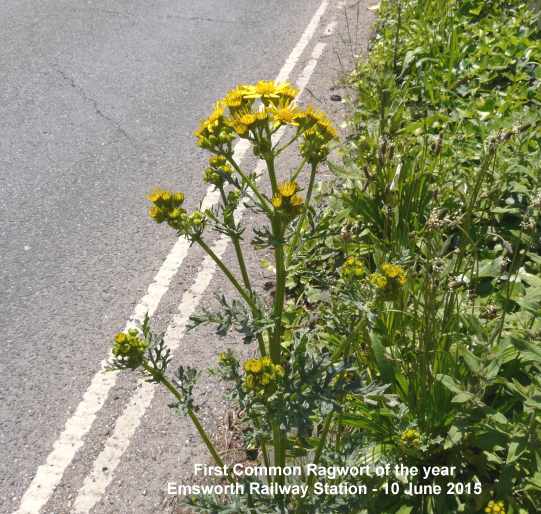
In total I logged 88
plant species from a total list of 169. My guess is
that many of the missing ones will have gone for good.
I saw both male and
female Common Blue butterflies, the female
settled for a photo.
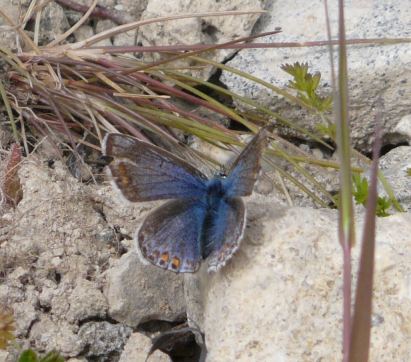
It was good to see
lots of Bumblebees feeding mainly on the clovers and
the Bird's-foot Trefoil.
I spotted a Common Lizard scuttling away from one of
the many black reptile mats.
Other notes: The
wayside notice on the eastern section is damaged and
needs replacing. I hope we can unsure that the plants
near the ramp are not chemically sprayed this year.
Bee
Orchids gone!
Di Ashe wrote
to inform us that the lovely array of 50+ Bee Orchids
that she photographed on the roadside near Warblington
roundabout a couple of days ago have gone! The Council
verge cutting team arrived this afternoon and mowed
them all down! As Di says it is unlikely they were in
flower long enough for seed to set. Clearly the
management at Havant Borough Council were not
listening to the chap from Plantlife on 'Springwatch'
last night who was encouraging councils to delaying
verge cutting until after the main flowering season.
However, there is probably no great damage in the long
run as all orchids are perennials with rhizomes or
tuberous roots and do not rely entirely on seed for
their propagation.
Here
is Di's photo just for the memory!
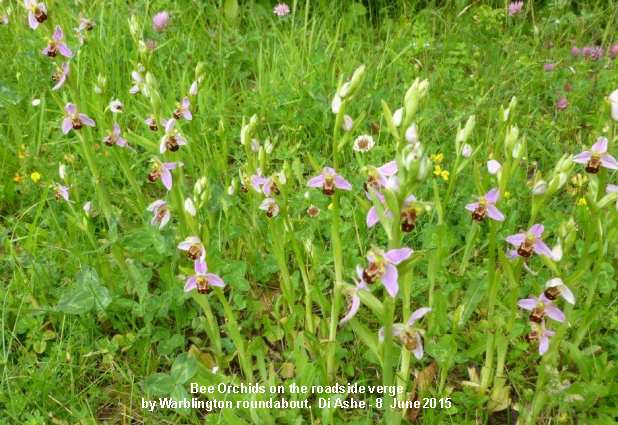
TUESDAY
JUNE 9 - 2015
Millpond
News
On the town
millpond the Mute Swan family of two adults and 5
cygnets was struggling a little in the very low water
channel at the bottom of Nile Street when I passed by
at about 11am this morning. However, all the cygnets
looked strong and healthy and growing well.
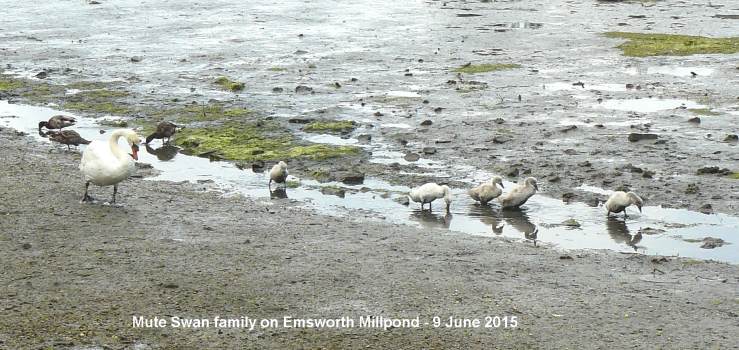
Over on Slipper
Millpond the two Great Black-backed Gulls were
on the centre raft with their two growing chicks
moving around on the raft. Here is a photo of one of
the parents and a chick, growing fast.
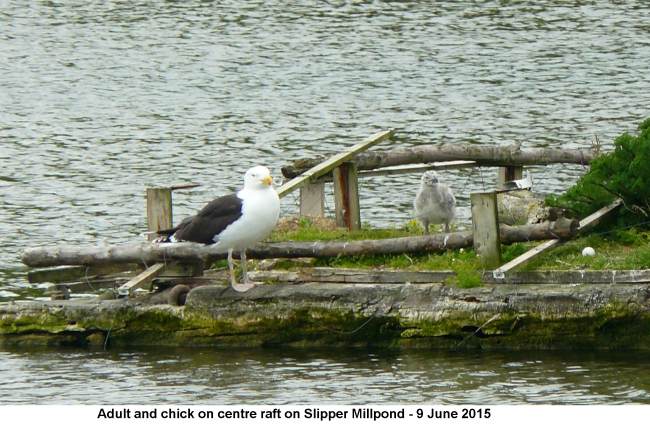
The raft now has a
luxurious growth of vegetation including a large
flowering plant of Hemlock Water-dropwort plus various
other plants, so the chicks have lots of cover. Some
of the wooden framework and wires that was originally
placed there to deter the gulls nesting appears to
have collapsed allowing much easier movement on and
off the raft for the adults.
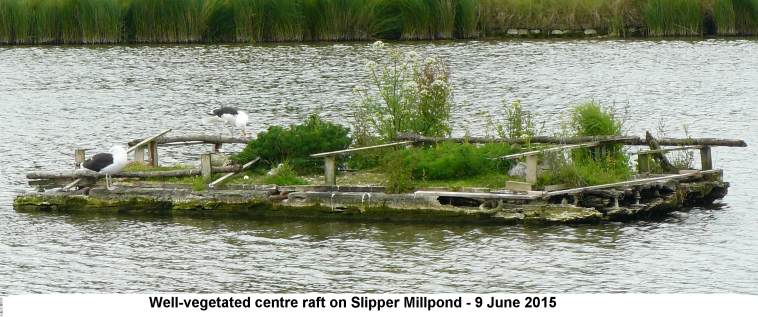
Brook
Meadow
Walking in
through the Lumley gate I was greeted by the loud song
of the resident Cetti's Warbler from the purple
leaved Cherry Plum 'Pissardii' on the causeway. It has
been heard since 19-Feb. I watched it fly across
towards the Lumley Stream, hearing it singing several
more times from that area. It is clearly a very mobile
bird and this probably accounts for my hearing it at
several locations around the meadow. Here is Malcolm
Phillips's photo of the bird from earlier in May.
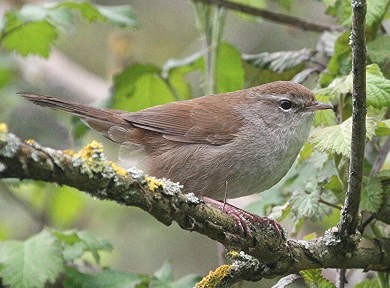
I found small amounts
of both Celery-leaved Buttercup and Toad Rush growing
very closely together in two locations: (a) in the
area north of the "Lumley puddle" and (b) on the small
casual route down to the Lumley Stream from the path
round the Lumley area.
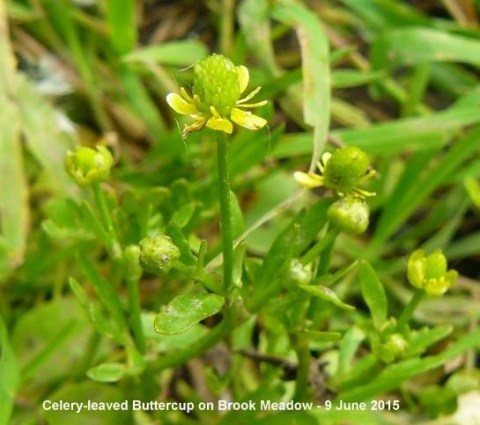
I met a couple of
self-confessed 'orchid addicts' on Brook Meadow this
morning. They were volunteers from the new RSPB
Medberry Reserve near Pagham and were very pleased to
hear about the orchids growing on Brook Meadow. They
were well-armed with large cameras and tripods. It is
interesting to hear that news of our orchids is
travelling far and wide.
MONDAY
JUNE 8 - 2015
Brook
Meadow - Guided walk
I was asked to
conduct this 2 hour guided walk of Brook Meadow for
the Rowlands Castle U3A naturalist group by my old
friend Jim Berry who is a member of the group.
Jennifer Rye brought along some new Brook Meadow
leaflets which I distributed at the end of the
walk.
We walked round the whole of the meadow, covering all
the main areas of interest.
We spent some time discussing the current parlous
state of the Water Vole population. We looked
where we could in the river, but did not see any sign
of a Water Vole.
We enjoyed listening to the bird song which was
present throughout the walk, particularly, Blackbird,
Wren, Chaffinch and Blackcap. The group was also
interested to hear the local Cetti's Warbler
singing from the area of Gooseberry Cottage. I
also heard what could have been a second Cetti's
Warbler singing from the north of Lumley copse.
The group were keen to see the orchids that were
currently in flower on the meadow and, most important,
we made some new discoveries. It just goes to show how
useful it is having several pairs of eyes looking. Two
members of group spotted two Bee Orchids on the
far eastern side of the Lumley area - the first of the
year in that area. This takes the total found so far
on Brook Meadow this year to six.
Here
is a photo of the group admiring the Bee
Orchids.
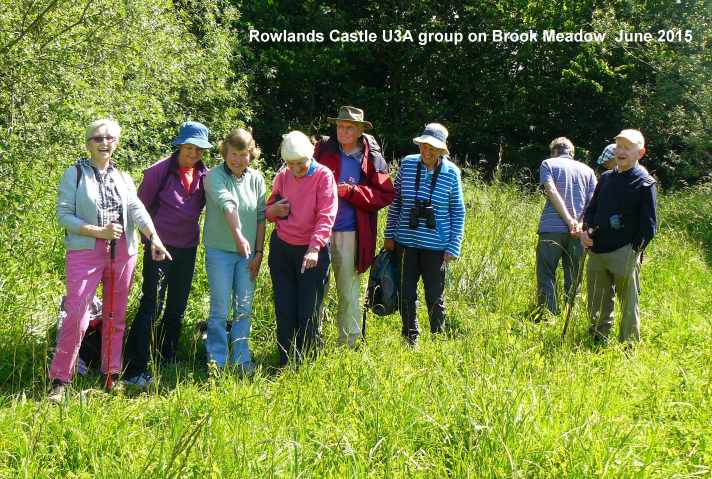
Here
is one of the Bee Orchids - what a beauty
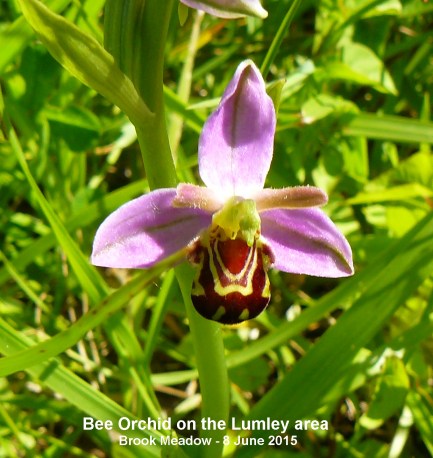
While looking around
the main orchid area, another member of the group
found a new Southern Marsh Orchid just to the
east of the main group of orchids on the north meadow.
Here is the group admiring these orchids.
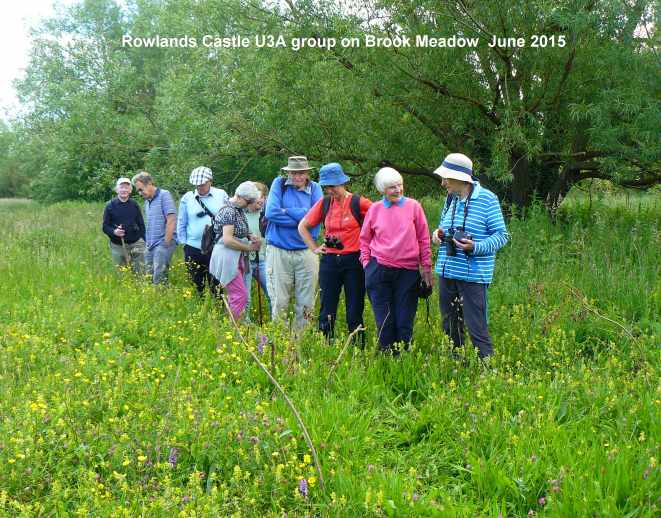
We also found the
first Hedge Bindweed of the year flowering in
this area.
I also introduced the group to some of the main
grasses and sedges that are currently in flower on the
meadow, explaining briefly the nature of their
flowering.
The only butterflies we saw during the walk were
Speckled Wood and Red Admiral. However, we got a good
view of a Hornet buzzing around on a path in
front of us near the arisings tip on the east side of
the meadow. Unfortunately, it did not stop for a
photo. But a female Beautiful Demoiselle with
blue body and brown wings was more obliging, basking
in the sunshine on a leaf with her brown wings. The
wings of a female Banded Demoiselle would be greenish.
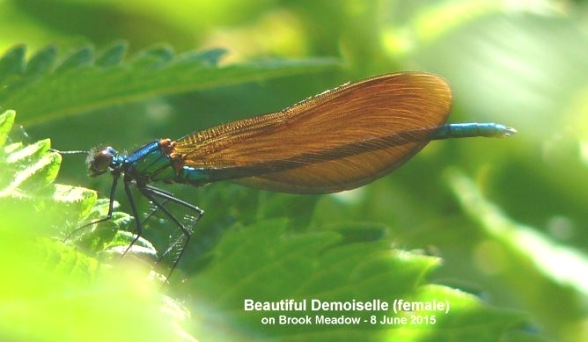
More
Bee Orchids
Di Ashe
spotted about 50-60 Bee Orchids in bloom just as you
come into Emsworth on the left by the roundabout from
the A27. "Magnificent to see so many in such close
proximity!" They must be having a good year? To see
them Di parked in the road to Warblington Church and
crossed over the road. An easier place to park would
be at the pull in just past the Boat
Planter.

SUNDAY
JUNE 7 - 2015
Brook
Meadow
I went over to
Brook Meadow this morning mainly to take photos of the
conservation work session. The morning was fine and
warm. The session was led by Wally Osborne and
attended by 10 volunteers. One task was to cut a
series of narrow paths through the dense vegetation on
the Seagull Lane patch to enable access to the Jubilee
hedgerow and various tree saplings. This will also
help to open up this area which has become very
thickly overgrown this year. Wally and Mike also put a
stake to support the smallest Oak sapling planted by
my wife, Jean in 2012.
Here
is Mike cutting his way through the jungle of
vegetation with the power scythe
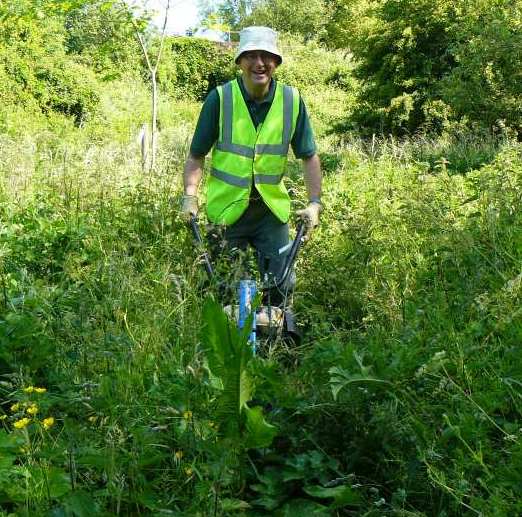
During this work I
noticed a Dog Rose bush in full blossom - a
beautiful sight. This was on the Jubilee hedgerow on
the west side of the Seagull Lane patch at Grid Ref:
SU 750001 06246.
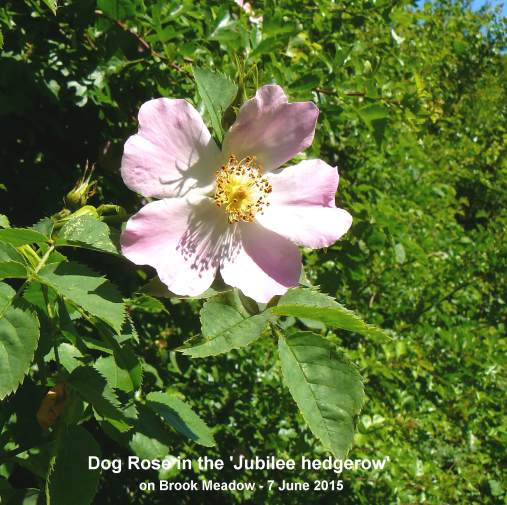
Ted
Aylett
Pam Phillips
informed us that sadly Ted Aylett had died. Ted had
moved away to Yorkshire to be near his daughter
following the death of his wife Penny in September
last year, but he was in poor health.
Ted and Penny Aylett were both founder members of the
Brook Meadow Conservation Group in the year 2000 and
held the inaugural meeting of the group at their house
in The Rookery on 24th August 2000. Most of the our
committee meetings for the next 3 years or so were
held at their house and Ted and Penny were such
generous hosts. Ted also acted as the group's
publicity officer for a time. Despite his increasing
ill health and loss of sight Ted continued to take an
active interest in Brook Meadow, attending work
sessions in the early days.
An
early workday group in December 2000 with Ted Aylett
prominent on the left of the photo.
Others from the left Tony Wilkinson (deceased), Viv
Harding, Brian Fellows,
Penny Aylett (deceased), Alison (BTCV) and Frances
Jannaway.
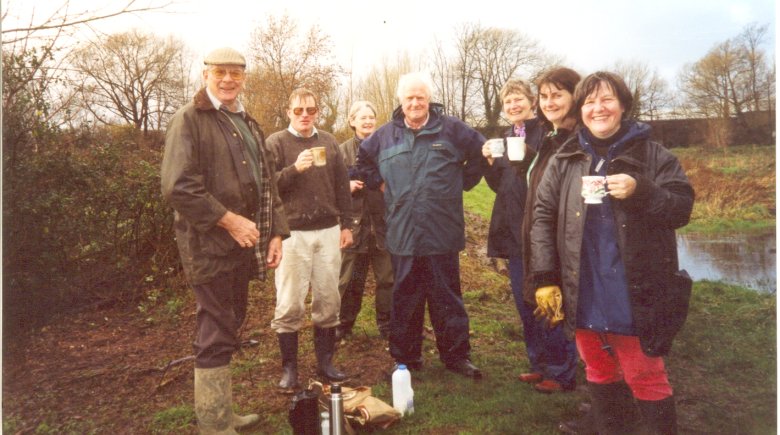
The funeral will at
The Oaks (Havant Crematorium) in Barton's Road on 16th
June at 11.30. Penny also had her funeral there on
September 19th 2014.
Butterflies
Despite the
warm morning I saw very few butterflies, just one Red
Admiral, one Speckled Wood and one Common Blue. The
Common Blue was the first of the year on Brook
Meadow.
Joyce Sawyer got another first of the year yesterday
with this Painted Lady feeding on Hemlock
Water-dropwort.
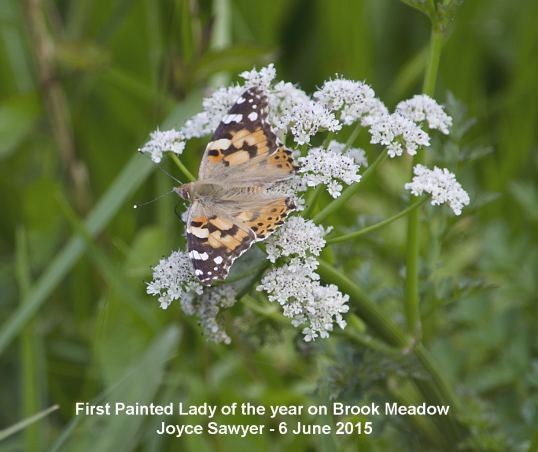
Painted Lady is a
migratory butterfly which is unable to survive the
British winter. Our populations originate from N.
Africa where numbers build up each spring leading to
annual invasions across Europe with some arriving in
Britain usually from June onwards. Very occasionally
they turn up in their millions as in the summer of
2008.
Bee
Orchids
I met Jill
Stanley and Di Ashe on the orchid area standing over a
small group of 4 Bee Orchids that Di has just
discovered in the long grass.
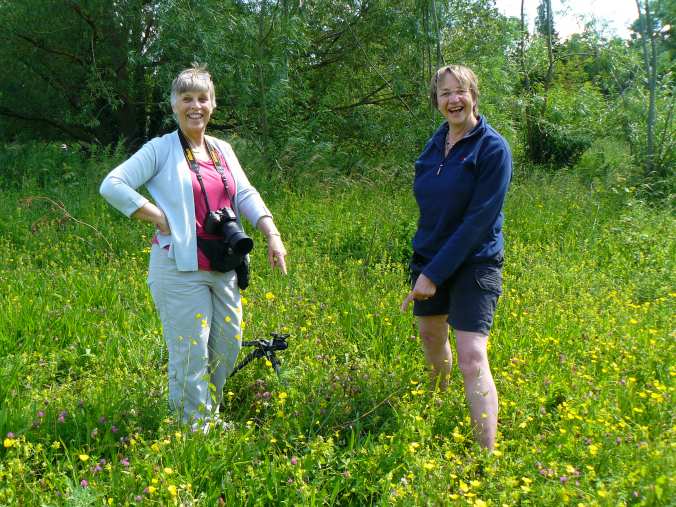
The Bee Orchids were
all marked with small twigs though, even then, they
were not at all easy to find. These were the first Bee
Orchids of the year on Brook Meadow at Grid Ref: SU
75069 06143. This is the spot where Jill and I found 5
last year. Last year we found a total of 12 Bee
Orchids on Brook Meadow, 7 on the orchid area, 4 on
the Lumley area and one on the centre meadow. So,
clearly we need to keep looking! But what little gems
they are!
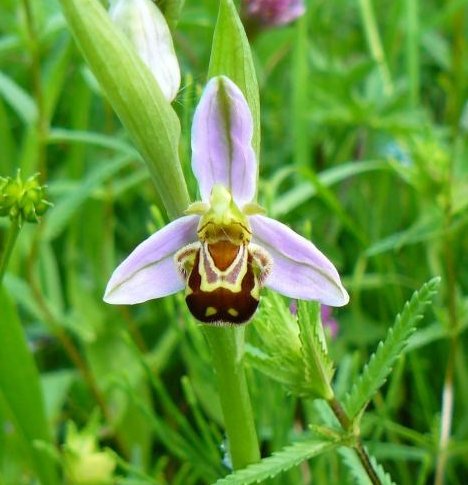
Jill also discovered
the first Lesser Stitchwort of the year on
Brook Meadow on the centre meadow just north of the
causeway at Grid Ref: SU 75093 06023. This is about 2
weeks later than last year, though that was
exceptionally early.
Stoughton
Orchids
Di Ashe had a
walk above Stoughton yesterday where she found about 6
Fly Orchids, 8 Greater Butterfly Orchids, perhaps 20
or so White Helleborines and hundreds of Twayblades.
Here
is Di's photo of one of the Greater Butterfly
Orchids
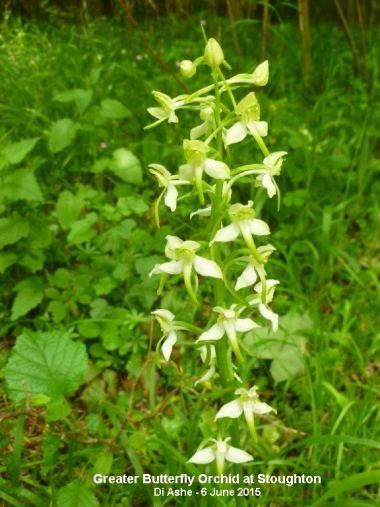
Di helpfully provided
directions if anyone would like to go and see them for
themselves: "Up behind the Church take the path which
is part of the Monarchs Way up the hill and turn
right. The Fly orchid group is about 20 paces along
the path on the right about 5 paces into the wood.
There are several Helleborines along on the left
mostly and a Greater Butterfly. On the right there are
many Twayblades all along. The first Butterfly orchid
is on the left, just after the footpath that goes down
the hill towards the pub. Approaching the second power
line swathe across the path, there is a very majestic
Butterfly Orchid on the left and several more can be
seen singly either side of the path further on and
also more Fly Orchids. We then turned left and came
back along the track through the middle of Inholmes
Wood, and several Common Spotted Orchids were seen.
"
Greylag
Goose at Baffins
Eric Eddles
was quite excited to see this Greylag Goose amongst
the many Canada Geese on Baffins Pond. The last time
he saw one on the pond was on the 12th of April
2006.
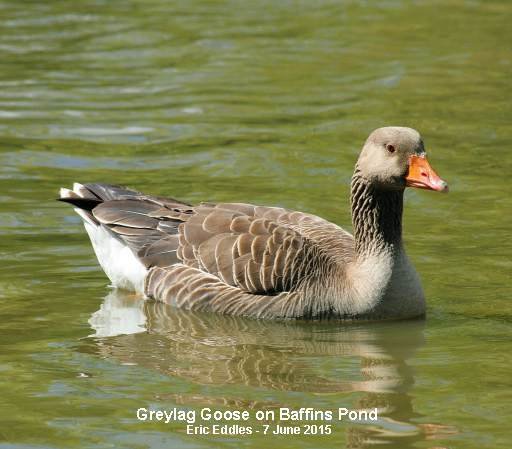
Titchfield
Canal
Chris Cope
reported on yesterday's walk by the Havant Wildlife
Group
See link to 2015 reports at . . . http://familyfellows.com/hwg-index.htm
SATURDAY
JUNE 6 - 2015
Orchids
on Brook Meadow
I had a walk
through Brook Meadow on a warm and sunny afternoon,
mainly to look for orchids. The group of five Common
Spotted Orchids, just outside the main orchid area to
the north of the twig barrier, are now looking very
good. I searched thoroughly for any Bee Orchids but
failed to find any.
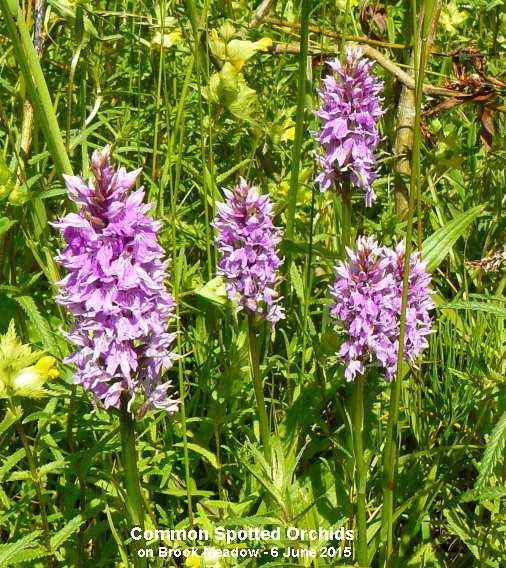
Cuckoo
Bumblebee ?
Despite the
warm temperature there were very few butterflies on
the wing. The only insect of interest that caught my
attention was a Bumblebee feeding on the flowers of a
Hemlock Water-dropwort plant on the Lumley area. This
bee had a single dark yellow band at the front of the
thorax (not shown too well in this photo) and two
yellow wedges on the end of the abdomen where the
black meets the white of the tail. All this strongly
suggests it is a Cuckoo Bumblebee, probably
Bombus vestalis.
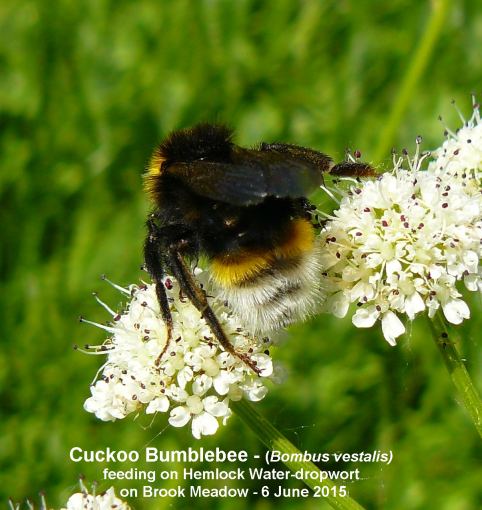
Interestingly, Thomas
Irons also got a photo of what was probably a Cuckoo
Bumblebee Bombus vestalis on May 27th at
Warblington. Here is Thomas's photo for comparison.
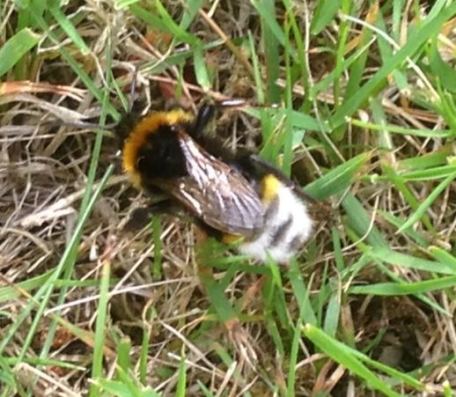
Bryan Pinchen agreed
that Thomas's photo showed Bombus
vestalis, although he thought there was a slim
possibility of it being B. bohemicus. He
says, "Both have a distinctive yellow wedge of hairs
between the black towards the tail tip, and the white
of the tail tip but often can't be separated without
microscopic examination. On balance,
vestalis is the more likely given that
it appears to be more widespread nationally than
bohemicus which tends to have a more
westerly distribution." The same argument probably
applies to the Brook Meadow bee.
Willowherb
at Chichester
I am grateful
to Ralph Hollins for correcting my identification of
the small willowherb that I found on the roadside in
Chichester yesterday. I thought it might be American
Willowherb, but Ralph rightly pointed out something I
had completely overlooked which ruled this out. He
noted that the fully open flower nearest the camera
showed a cross-shaped stigma in the centre of the
flower and this cross-shape indicates Broad-leaved
Willowherb. American Willowherb on the other hand has
an upright, club-shaped stigma. See Rose 'The Wild
Flower Key' p.298.
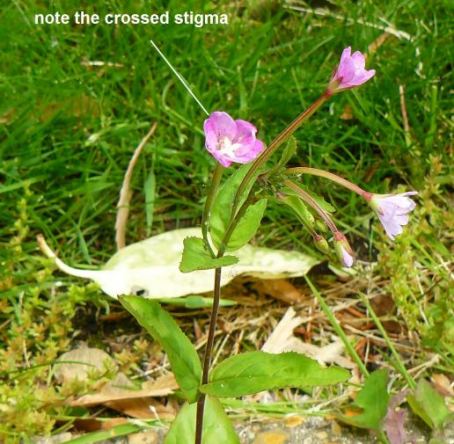
Blue
Water-speedwell
Ralph Hollins
also commented on the Blue Water-speedwell, which is
now in flower on the east side of Peter Pond at Grid
Ref: SU 75284 05856. However, it is necessary to
determine whether the plant is the genuine Blue
Water-speedwell (Veronica
anagallis-aquatica) or the hybrid between Blue
and Pink Water-speedwell called Veronica x
Lackschewitzii which continues to spread. So,
as Ralph says, there is no guarantee that the Peter
Pond plant is 'true blue'.
The best way of distinguishing the genuine blue from
the hybrid is by counting the number of flowers in a
raceme; the hybrid has many more flowers than the
genuine version. The BSBI Plant Crib says the value is
14 to 40 flowers (with a mean of 25) for the genuine
Blue species and from 30 to 90 (mean 60) for the
hybrid. I recall the late Pete Selby's criterion was
stricter, saying that anything over 20 flowers on the
longest raceme meant it was a hybrid. Also supporting
the hybrid identification would be the absence of
capsules on any of the plants as the hybrid is not
fertile.
However, Ralph says, to count the flowers in a raceme
is almost impossible till late in the season when the
tight packed flower buds at the tip of the raceme have
mostly opened leaving countable flower pedicels spread
out along the raceme. So, at present, it is much too
early to be sure of separating the true species from
the hybrid but Ralph thinks the photo I took on Peter
Pond on June 3 suggests a low count and thus the
likelihood that this is true species.
Here is another photo of the Peter Pond plant I took
today. Some of the racemes do look as if they have
more than Pete Selby's criterion of 20 flowers,
suggesting the hybrid.
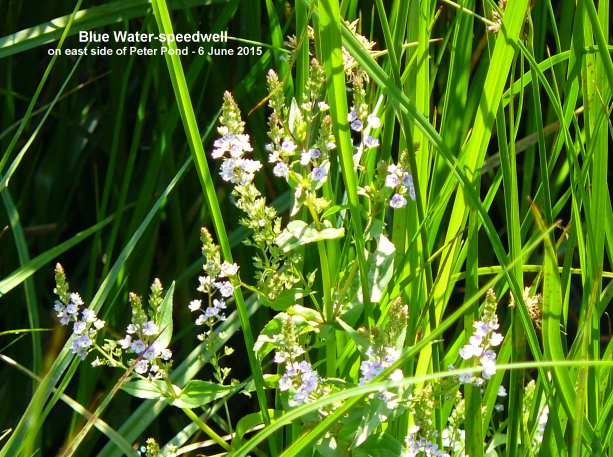
FRIDAY
JUNE 5 - 2015
Wild
Clary on Christopher Way
There are
about 4 plants on the main wayside with some flowers.
Here is one of them.
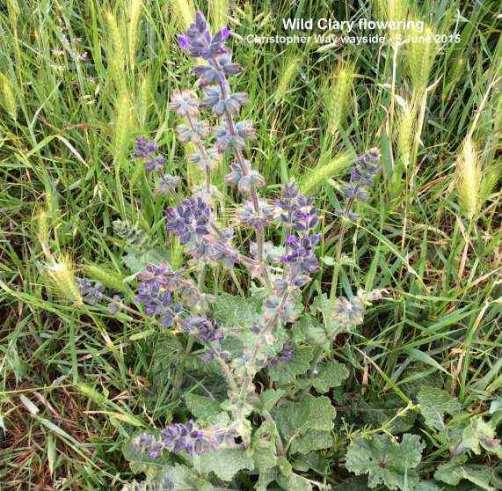
A new notice on the
wayside near to the Wild Clary plants gives
information about these rare flowers.
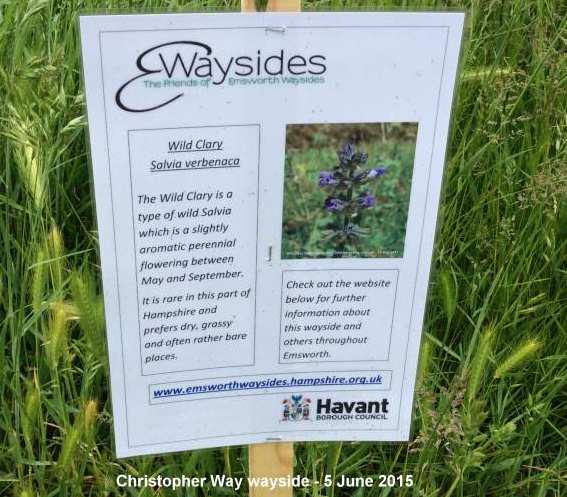
There are many more
Wild Clary plants in flower on the council verge
further to the west, though these will probably soon
by mown along with the rest of the verges, but they do
not appear to have suffered as a result of the mowing
in the past. Grid Ref: SU 74865 06900.

American
Willowherb? . . . CORRECTION
- see below
I saw this small flowering willowherb on a roadside in
Chichester this afternoon. Small willowherbs are
notoriously difficult to separate, particularly the
native Broad-leaved Willowherb and the alien American
Willowherb. Both are common on pavements and
roadsides. My photo does not really enable one to go
for either with any great confidence, but overall my
preference is for American Willowherb (Epilobium
ciliatum). Points in its favour include the
reddish stems with raised ridges, the hairless leaves
and what looks like glandular hairs on the main stem,
attracting lots of green aphids.
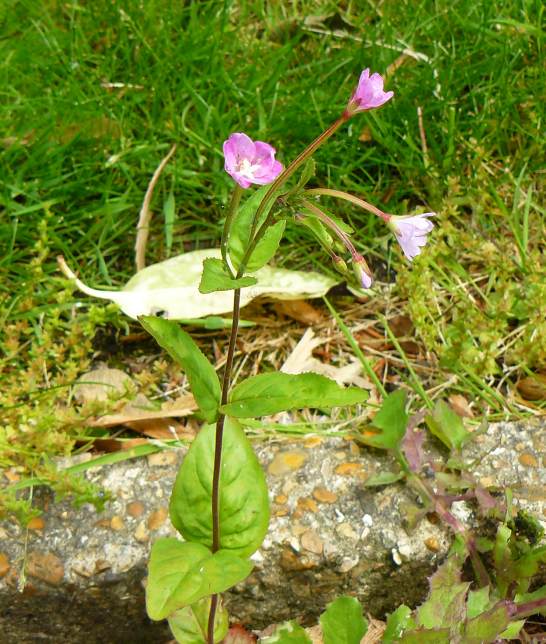
CORRECTION
- Ralph Hollins rightly pointed out something I had
completely overlooked - that the fully open flower
nearest the camera showed a cross-shaped stigma in the
centre of the flower and this cross-shape indicates
Broad-leaved Willowherb. American Willowherb on the
other hand has an upright, club-shaped stigma. See
Rose 'The Wild Flower Key' p.298.
Chichester
Peregrines
I checked on
the Peregrines nesting on Chichester Cathedral this
afternoon at the excellent RSPB watch point in the
cafe garden behind the Cathedral. I was informed by
one of the volunteers that the three chicks were being
well provided with food by both parents and were
growing fast. The three, three week old, Peregrine
chicks were ringed on 31 May 2015 by ecologist Graham
Roberts. There are two females and one male chick. All
are fit and healthy. The male weighs 600g and the
females weigh 840g and 855g. The female Peregrine is
always much larger than the male. The young birds'
wing feathers are developing and it is expected they
will fledge in two and a half weeks time. Here is a
snap I got of the chicks in the nest on the monitor in
the RSPB tent, the male is on the left and the females
are together on the right.
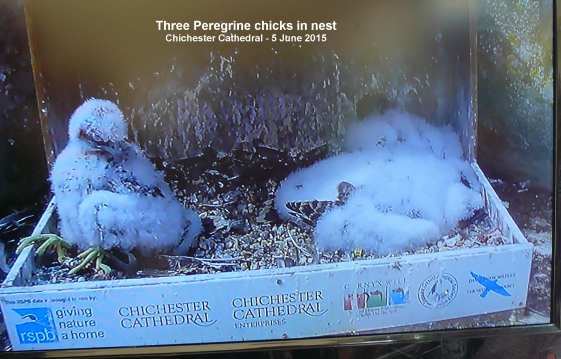
To see live pictures
from the nest go to . . . http://www.chichestercathedral.org.uk/whats-on/cathedral-peregrines.shtml
THURSDAY
JUNE 4 - 2015
Millpond
News
The Mute
Swan family was on the town millpond near the
bridge with the 5 remaining cygnets all growing
rapidly. It is amazing how they have come on in the
past few days. They are fast catching up the Mallard.
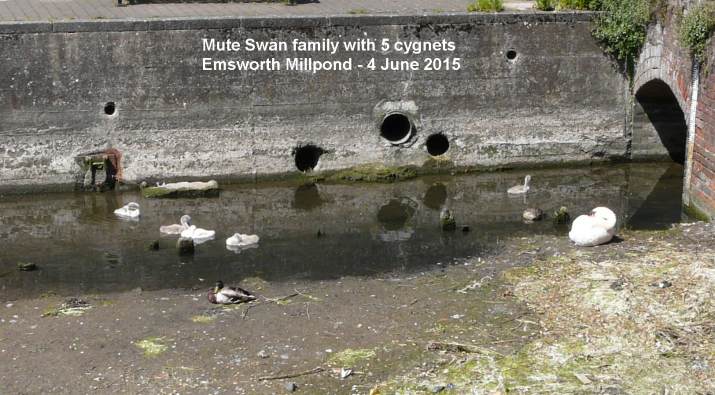
The pair of Great
Black-backed Gulls was on the centre raft of
Slipper Millpond with their two chicks. All was quiet.
Two Mute Swans were present, the regular cob on Peter
Pond and its mate (to be) on Slipper Millpond.
Sea
Trout
From the small
footbridge to the north of Peter Pond I could see two
fairly large Trout in the stream below me. They were
much darker than the Brown Trout we get in the River
Ems and the spots seemed to be more numerous, almost
mottled. These presumably will be Sea Trout that move
up from the harbour. Please correct me if I am wrong.
I tried to get a photo, but my point and shoot camera
does not cope well with water, so this was the best I
could get. The head is facing down in the
photo.
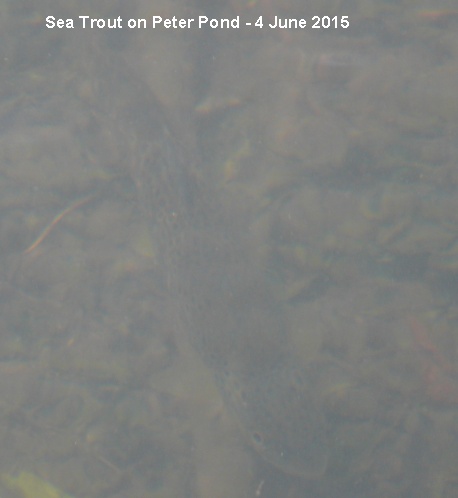
I read in my guide
that Sea Trout feed on small fish such as sprats and
grow much faster than the river-dwelling Brown Trout
whose diet is mainly invertebrates, such as freshwater
shrimps and insect larvae. This diet apparently
accounts for the reddish spots on the flanks of Brown
Trout, whereas the Sea Trout tend to be darker.
Brook
Meadow
There is a
good crop of Common Spike-rush now showing on
the Lumley area along with the abundant Divided Sedge,
Distant Sedge and False Fox Sedge. There was no sign
of Toad Rush as yet. The leaves of
Pepper-saxifrage are now showing in the usual
place on the east side of the Lumley area. I found my
first Brooklime of the year in flower on the
edge of the Lumley Stream, but no sign of Blue
Water-speedwell which I usually see here as well.
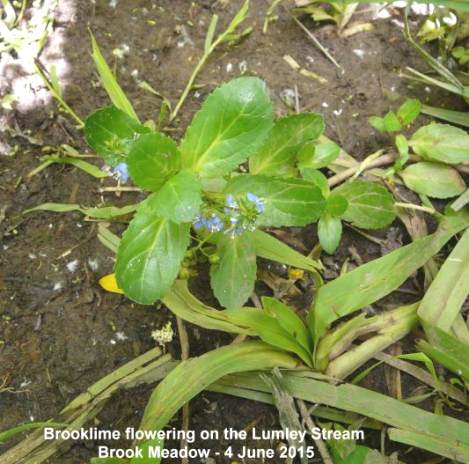
I looked hard for Bee
Orchids on the main orchid area in the north meadow,
but did not find any. However, I did find another two
Common Spotted Orchids in much the same place
as last year, growing close to a bush of Meadowsweet.
I marked them with a tall stick. Their spotted leaves
show up well in this photo.
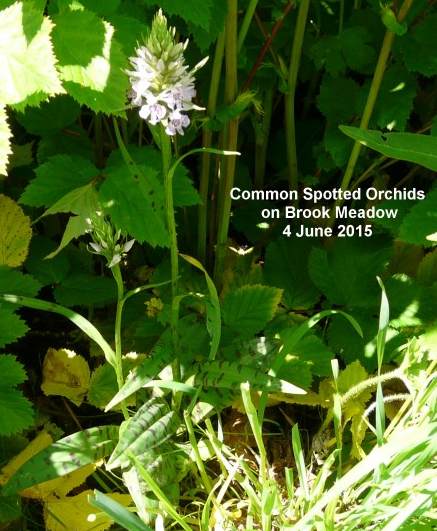
Jill Stanley also went
looking for orchids on the meadow this afternoon and
found an unmarked Common Spotted Orchid, albeit a
small one that was only just coming out - picture
attached. This is almost certainly not one of the pair
I found this morning, so that adds another one to the
total taking it to 8 in all, equalling the record for
Common Spotted Orchids set in 2010.
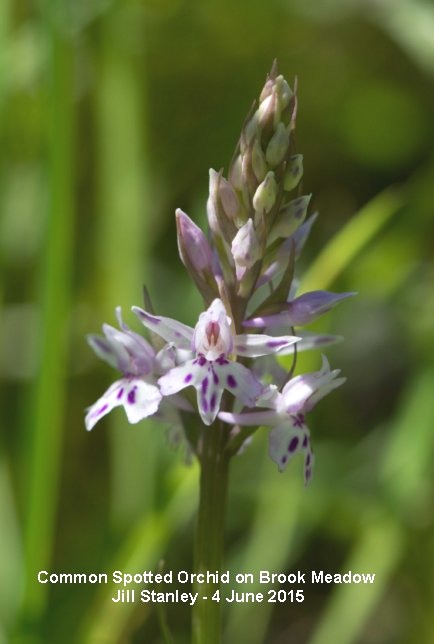
I also found another
Southern Marsh Orchid about 20 metres to the
west of the main group. This takes this year's total
of Southern Marsh Orchids to 20 (a new record). Some
of the older Southern Marsh Orchids are now looking
very good.
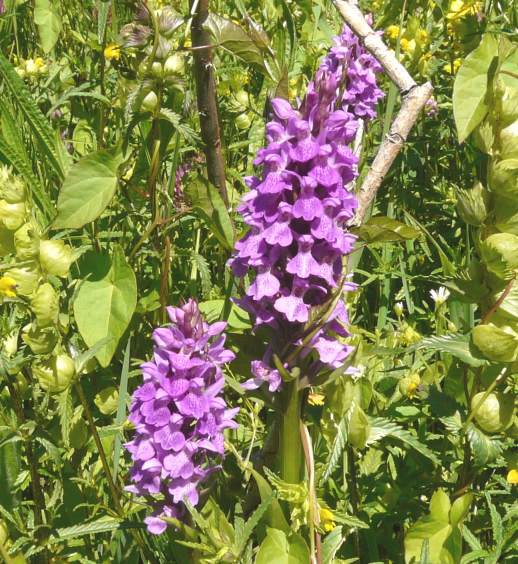
There were lots of
little white moths fluttering around the orchid area.
These are called Grass Rivulets and their
larvae feed on Yellow Rattle. This is a photo I took a
couple of weeks ago.
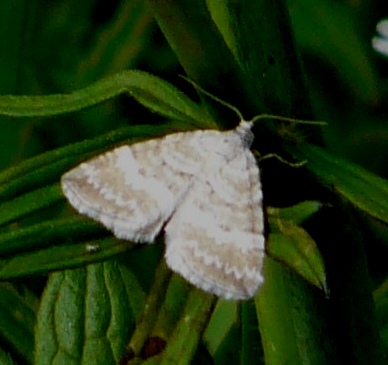
During my walk on the
meadow, I met Tess, an ecologist, who was in the
process of relocating Slow-worms from a housing
development site in Southbourne to Brook Meadow. This
is the same group that relocated both Common Lizards
and Slow-worms last year onto Brook Meadow.
WEDNESDAY
JUNE 3 - 2015
Brook
Meadow
I had a good
mooch around the orchid area, but did not find any
more orchids to add to the 17 Southern Marsh
Orchids and 5 Common Spotted Orchids
already found in this area. There was no sign of any
Bee Orchids as yet, though they are always difficult
to find in the long grasses. I noted the distinctive
greyish leaves of Hoary Ragwort are now showing
well in this area along with lots of Common
Fleabane.
However, my best find of the morning was the first
Great Burnet of the year in the same place as
last year on the main orchid area at Grid Ref: SU
75068 06131.
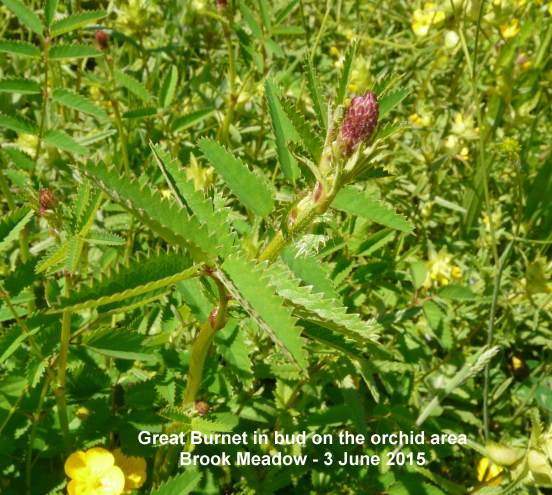
This is now the third
year we have been graced with this rare plant. When it
was first discovered in 2013 this was the first
Hampshire record in SU70 for Great Burnet
(Sanguisorba officinalis). Martin Rand
said, as a native in South Hampshire it is confined to
the New Forest where it is one of several "hay meadow"
constituents of base-rich flushed heathland in the
south of the Forest.
I also had a mooch around the Lumley area where I
located the two Southern Marsh Orchids that
Jennifer Rye found, taking the grand total so far for
the Brook Meadow site to 19. These two plants are not
together on the Lumley area but separated by about 10
metres. I would suspect that seeds from the orchid
area plants have been inadvertently transferred to the
Lumley area on people's shoes.
Ragged Robin
are now going over. Today's count came to less than
the 34 that I counted on May 27th, so I shall take
that as the annual count for 2015 which is very low.
The chart below shows the maximum counts each year
from 2002. The counts have been very variable over the
years. Following a record 625 in 2010 the count fell
to 214 in 2011 and then plummeted in Years 2012 and
2013. The count in 2014 was up to 104, but it fell
again to just 34 flowering plants this year. I have no
idea why the numbers of this very attractive plant
fluctuate so much.
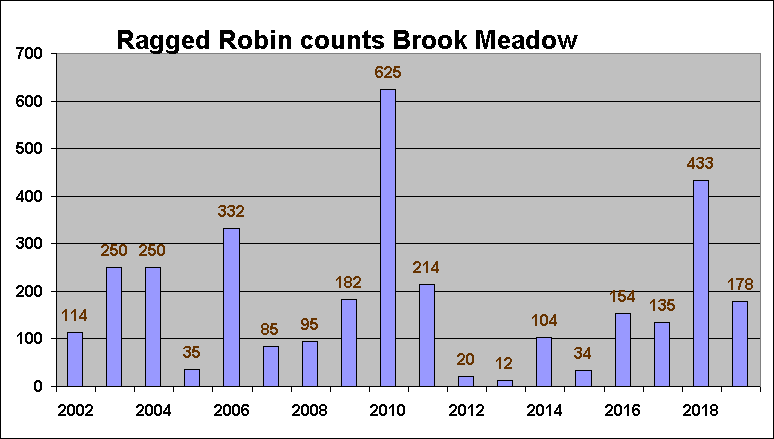
A Cetti's Warbler
was singing strongly from Lumley copse area. A
Red Admiral was flying - the first I have seen
for a while. This must be the first of the migrants
from the Continent which will soon be flooding into
Britain.
Millpond
News
The Great
Black-backed Gulls were both on the centre raft on
Slipper Millpond with their two chicks - follow the
thin white lines on the photo.
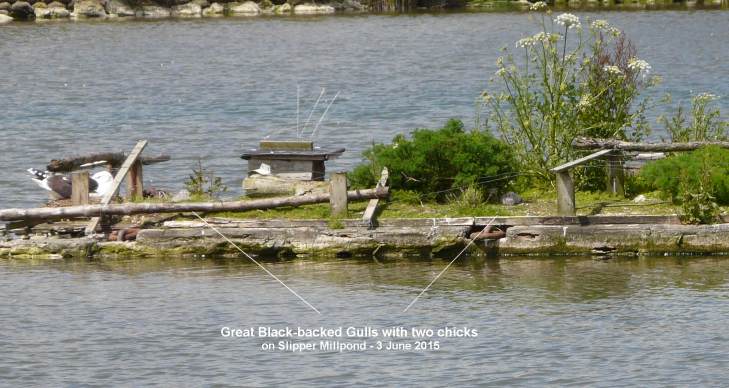
The Coot is
still sitting on the nest on the north raft. Hemlock
is in flower on the east side of Slipper Millpond.
I found Blue
Water-speedwell in flower on the eastern side of
Peter Pond along with more Celery-leaved Buttercup and
Water-cress.
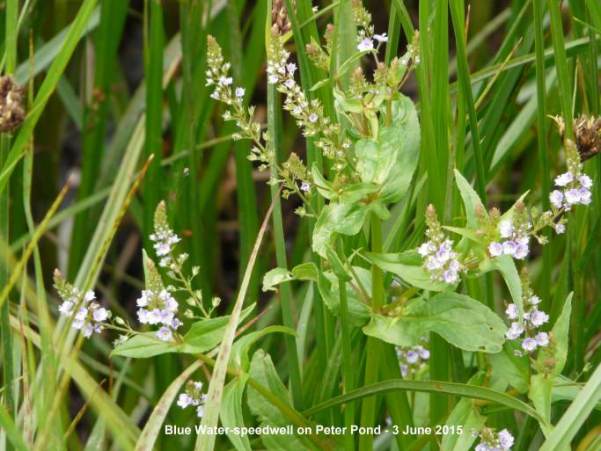
TUESDAY
JUNE 2 - 2015
Grass
Vetchling
Joyce Sawyer
sent me the following photo asking if I could identify
it for her. She had searched the internet and various
books without success. Joyce said her husband took the
photo in an uncultivated part of the field opposite
the Havant Crematorium, but they have also seen them
on Northney Common, Hayling.
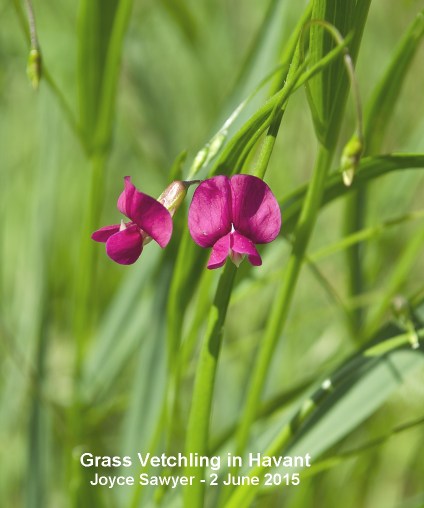
Joyce's very beautiful
jewel-like crimson flower is the one-and-only Grass
Vetchling, named after the fact that its leaves are
very thin and look like grass. The Hants Flora
describes it as 'local but increasing' which is good
as this is a flower to be cherished. Grass Vetchling
is mainly confined to the south and east of England. I
think Northney Common is the best place to see it
locally. But the field opposite the crematorium is a
good record for this scarce plant.
MONDAY
JUNE 1 - 2015
Millpond
News
The Mute Swan
family on the town millpond is now down to 5 cygnets.
They started with 8, then lost two following attacks
by Herring Gulls. The third cygnet must have been lost
while I was away over the weekend. I don't know what
happened. Does anyone know?
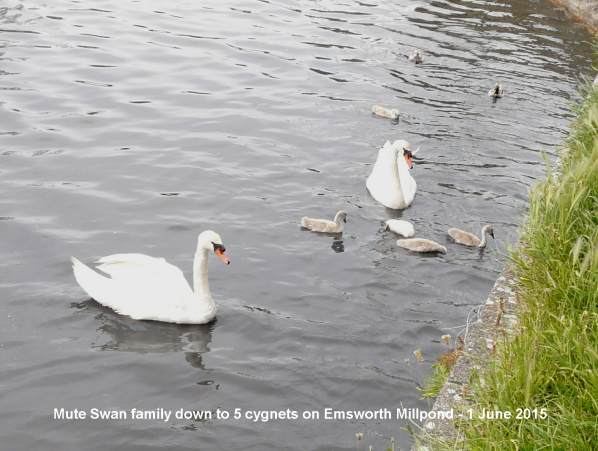
I checked the Slipper
Millpond nest where the two Great Black-backed Gull
chicks are still active on the raft.
Speedwell
correction
I am grateful
to Ralph Hollins and Jill Stanley for correctly
identifying the hairy speedwell I found on Bridge Road
Wayside on May 28 as Wall Speedwell and not
Thyme-leaved Speedwell as I first thought. I should
have know this as I have found Wall Speedwell on the
Bridge Road Wayside in previous years.
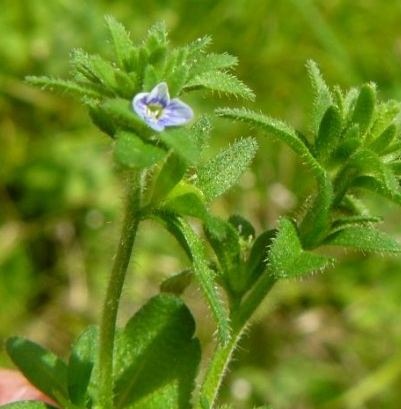
As Ralph rightly
pointed out "although the flowers of Wall Speedwell
are usually bright blue and your photo shows pale
streaked flowers like those normally found on
Thyme-leaved Speedwell everything else about your
photo suggests that this is Wall Speedwell which is
abundant at present".
More
orchids
On May 28
Jennifer Rye discovered the first Common Spotted
Orchids of the year; 5 plants were flowering just
north of the new perimeter barrier that the
conservation group built which is roughly where they
were last year. We should be getting others. We are
also expecting Bee Orchids fairly soon, though they
are a devil to find among the long grasses.
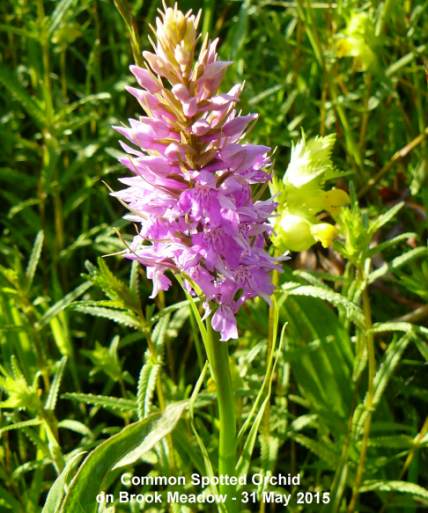
Today, Jennifer called
in to tell me she had found two more definite
Southern Marsh Orchids on the Lumley area,
taking the total so far this year to 19. These new
sightings are particularly welcome as they are well
distant from the main orchid area and indicate the
plants are gradually getting established generally.
Cuckoo
Bumblebee ID
Thomas Irons
took this photo of what looked like a Cuckoo Bumblebee
on May 27th. I asked Bumblebee expert Bryan Pinchen to
have a look at the photo and he tentatively agreed
with my identification of the bee as Bombus
vestalis, although he thought there is a slim
possibility of it being B. bohemicus.
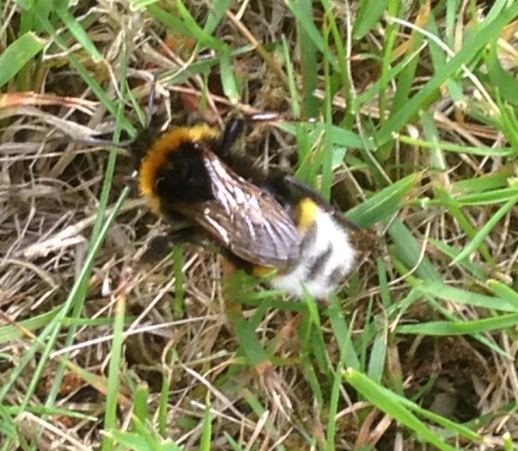
Bryan says, "Both have
a distinctive yellow wedge of hairs between the black
towards the tail tip, and the white of the tail tip
but often can't be separated without microscopic
examination. On balance, vestalis is the more likely
given that it appears to be more widespread nationally
than bohemicus which tends to have a more westerly
distribution. However, this may be due to recorder
bias of thinking 'its in the east therefore it must be
vestalis' and vice versa".
Bryan also cleared up a nomenclature issue. I had
called Thomas's bee Psithyrus vestalis which is
the name given in my old copy of Chinery. However,
Bryan says all cuckoo bumblebees now come under the
genus Bombus, like their hosts.
Ralph Hollins gave a link to a very useful web site
which tells you all you need to know about Bumblebees
and Cuckoo Bumblebees . . . http://www.buzzaboutbees.net/bumblebee-cuckoo.html
Hayling
Oysterbeds update
Chris Cockburn
provides the most recent news from the oysterbeds
"Hello, here is a much belated update of the 2015
breeding season at the Hayling Oysterbeds. Just like
2014, the first black-headed gulls and Mediterranean
gulls arrived on the lagoon islands on February 14th.
Numbers of both species rapidly increased as March
progressed and, although not properly counted, the
numbers of Mediterranean gulls seemed to be much
higher than in 2014. None of the Mediterranean gulls
or Sandwich terns nested on the lagoon islands this
year. The black-headed gulls started nesting in the
first week of April, as in previous years. Common
terns started visiting the site in the third week of
April and appeared to be finding silvery fish prey,
presumably herring sprats.
On 05 May, a low pressure system and its associated
strong winds (F8/9) caused damaging waves and a tidal
surge (the Cambernet weather & tide station showed
that the predicted 4.6m high tide had surged to
5.28m).The result was that apart from the nests on the
top of the western half of the straight island, all
other nests were washed into the lagoon along with
eggs and a few chicks (an estimated 500 nests were
lost). Those gulls that had lost eggs soon started
re-nesting.
Here is a photo taken 06 May when the tide level was
5.05m (using a macro lens and trying to keep steady
while the wind was gusting at 48 to 58
mph).
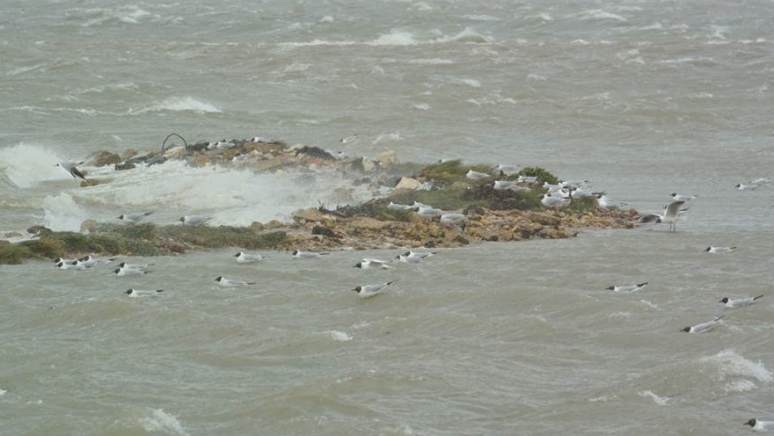
By 10th May, some
black headed gull eggs had hatched and chicks were
becoming visible; but 14th May was a cold and wet day
with prolonged periods of rain and it is highly likely
that some of the chicks perished from hypothermia.
By 17th of May, encouragingly high numbers of common
terns were on the straight island and a few scrapes
were becoming active. Nearly all the common terns were
on the northern edge of the straight island and
therefore not readily visible from the mound.
During the night of 18th May, another tidal surge
occurred (slightly lower than the previous one at
5.22m); once again many nests were lost. It seemed
that the common terns realised the dangers of nesting
on the northern side of the island and a great many
are now nesting atop the straight island. Meanwhile,
some of the black headed gulls are busy on their third
attempt at nesting; they certainly are a tenacious
lot! So, presently, it is a very busy colony with
chick feeding, nest building, egg incubating etc - oh,
and it is quite noisy too.
Two or three pairs of oystercatchers have now been
nesting on the islands for a week or so and if all
goes well their eggs should hatch in about four weeks'
time.
No little terns have attempted nesting at the
Oysterbeds, but one or two have been seen fishing have
been seen fishing in the area. They are probably best
viewed from the eastern sea wall at FM (from a point
south of the Deeps); look eastwards towards Baker's
Island and South Binness Island.
No ringed plovers have attempted nesting in the lagoon
area.
For
earlier observations go to . . May
14-31